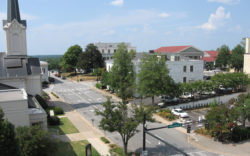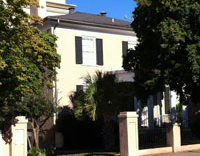I was a little surprised to see that the drawings produced by Columbia Residential’s architectural team as they sequestered themselves from the frenetic fieldwork of UGA landscape architecture students and faculty at last fall’s charrette on the reconstruction of the Jack R. Wells Homes public housing project—commonly known as Pauldoe—remained unchanged in a recent presentation by the Athens Housing Authority to the Athens-Clarke County Commission. The AHA would like the county to chip in to finance some of the infrastructure for the redevelopment (to the tune of $700,000 or $1.4 million). The hope is that the county match will sweeten the application that they’re putting forward to the state Department of Community Affairs for federal tax credits to subsidize the project.
If the AHA is passing the hat, looking for a million and a half dollars, perhaps a less garish design would be appropriate: one, for instance, that doesn’t attempt to put apartments in a very expensive bridge over the entry drive or a flat Savannah-style town square on a steep hillside. As yet, the drawings seem untested by the realities of budget or site. If these are indeed as preliminary as they feel, then a public meeting with the Mayor and Commission seems a strange place to show them off.
I do appreciate the Housing Authority’s ambition in transforming this “project†into a real community, but the design solutions proposed thus far need a great deal more investigation, especially if the county’s taxpayers are going to be on the hook for it. A grand gateway does not a neighborhood make. It’s even stranger given that these sorts of “gateway†moments in urban design are more often touted in single-entry, auto-oriented subdivisions than real neighborhoods where folks are walking, biking and busing in many different directions. A real community is a combination of many more nuanced factors than a couple of off-the-shelf New Urbanism-lite design features. The goals of this project are good, and AHA’s headed in the right direction, but their design isn’t at the same level, and I hope they get it there.
Part of the Housing Authority’s argument for the county’s investment in this project is that it will pay for itself over time, as the market-rate and subsidized units that will supplement the public housing there will be on the tax rolls. This isn’t the first road project ACC has been asked to get involved in lately, with the Orkin tract’s service roads also being a county-financed incentive for Caterpillar and its suppliers. The Selig team has also suggested to at least a few locals in its off-the-record and unaccountable meetings that it would expect the county to be involved in paying for some of the upgrades to Oconee Street and other corridors that its proposed development would necessitate. It has more generally and consistently made the argument that its project, because of a substantial augmentation of the property tax base, deserves to be approved.
These are interesting decisions to consider, in that they could bring the local government back to a role that it hasn’t had in at least a generation: the construction not just of arterials, but of the fabric of neighborhood streets, be they residential, industrial or commercial in their orientation. That role has long been filled by the developers of the various suburban versions of those land uses, and we’ll likely see more of this type of project locally as the greater real estate market turns back toward the city. The question, then, becomes: will the city, asked to finance this infrastructure, assert its own values in the planning and design of these places? If not, the suggestion is simply that the county government is there to provide free roads for whomever would increase the tax base in a timely enough manner to “pay back†the investment.
Of course, there are presumed external benefits to the infrastructure for these projects—high-paying jobs in the case of Caterpillar; workforce housing in the case of AHA—but that doesn’t preclude the broader investigation of the planning and design of these county-financed areas. If the city is now responsible for paying for streets, then it seems like the platting and planning should be their prerogative, as well, with other priorities, such as a more walkable and bike-able grid, management of on-street parking and provision of open space all becoming very public concerns. If this public planning and financing were carried out on a large scale, we might see a reversal of the disconnected character that plagues suburban parts of the county.
It happened before, and we have places like downtown as a result. Maybe it could happen again.
Like what you just read? Support Flagpole by making a donation today. Every dollar you give helps fund our ongoing mission to provide Athens with quality, independent journalism.










